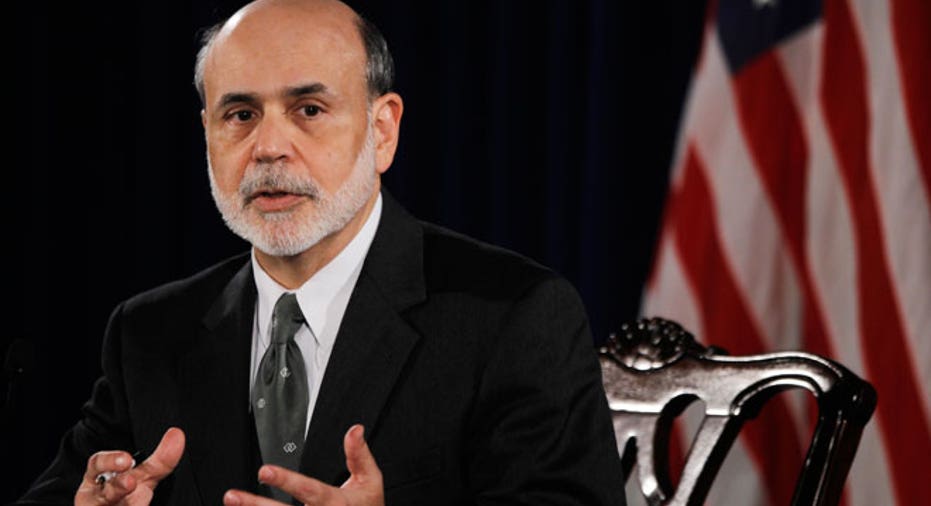The Inflation Spike That Never Was

Listening to inflation hawks in recent years, one could have easily imagined that by 2012 the U.S. and most developed economies would be hobbled by rampant inflation caused by central bankers flooding the global financial system with easy money.
Yet, by almost all measures, inflation remains largely restrained, especially compared with the dire predictions that emerged after the Federal Reserve slashed interest rates near zero and unleashed QE1 and then QE2.
The mysterious lack of inflation -- for now -- can largely be chalked up to the anemic economic recovery, but doesn’t preclude a future spike in prices if the Fed fails to play its cards right.
"Even though the Fed's balance sheet has exploded since the financial crisis, inflation will not happen until economic activity picks up,” Cam Harvey, a finance professor at Duke University, wrote in an email. “At that point, the Fed faces a choice: inflation or aggressively reduce the size of their balance sheet.”
Inflation Metrics Stay Muted
For now, inflation seems to largely be missing in action.
Global consumer prices increased at a modest 3.1% year-over-year in June, but prices gained just 2% among the more developed economies represented by the OECD. Inside the G7, CPI inched up just 1.6%.
The same story largely holds true inside the U.S., where consumer prices increased only 1.4% in July from the year before -- well below the Fed’s 2% target. Excluding volatile food and energy prices, core inflation rose 1.8%.
“Where in the world is inflation? It’s almost nowhere, or at least it’s very hard to find,” Ed Yardeni, president and chief investment strategist at Yardeni Research, wrote in a note.
Thanks to the bloated balance sheets of the Fed, European Central Bank and elsewhere, Yardeni’s global liquidity supply measure has doubled since June 2007 to a record of $13.7 trillion in May. Yet the International Monetary Fund’s global CPI is up just 20.6% over that span.
Likewise, global liquidity has surged 17.6% annually over the past 10 years, compared with a 3.8% annual rise in global CPI, Yardeni said.
“Despite massive injections of liquidity by the world’s major central banks, inflation remains remarkably subdued,” said Yardeni.
‘Stunted’ Growth Keeps Inflation at Bay
To solve this riddle, most economist point to the lackluster growth gripping much of the developed world as consumers and businesses continue to de-leverage and banks grapple with higher capital standards.
Gross domestic product in developed economies ticked up just 1.3% in 2011 and is seen increasing only 1.4% this year, according to Barclays (NYSE:BCS). U.S. GDP rose a feeble 1.8% in the second quarter and is expected to hit an uninspiring 2.6% in 2013.
“Inflation is low today because the velocity of money has plunged due to stunted economic growth, high unemployment, and feeble capital expenditures by businesses,” said Harvey.
In particular, Yardeni cited labor costs that have been suppressed by cheap labor in emerging economies and weak growth. Last month the average hourly earnings measure of wages rose just 1.7% year-over-year.
“Inflation doesn’t become a serious problem until you have wage pressures bubbling. We’re obviously nowhere near that. There’s a massive supply of labor out there," said Omair Sharif, U.S. economist at Royal Bank of Scotland (NYSE:RBS).
Food, Energy Prices Debated
However, John Ryding, chief economist at RDQ Economics, dismisses the thinking that inflation isn’t a worry because labor costs are under wraps.
“We don’t believe inflation is a labor market phenomenon,” said Ryding. “Given the level of unemployment we have, the labor-based theories of inflation should have had us in a period of deflation by now. Why are prices rising at 2% and not falling?”
Of course, inflation could soon show more signs of life, especially if the economy unexpectedly picks up steam, or more likely through recent increases in energy prices fueled by geopolitical tensions or eventually from higher food prices caused by the U.S. drought.
Still, none of those developments, short of an oil price spike caused by an Israeli airstrike on Iran, seem likely to produce the type of headline inflation envisioned by inflation hawks years ago.
“It’s certainly broadly true that inflation has remained much more subdued than a lot of the inflation hawks have been concerned about,” said Sharif.
What if Fed Fumbles its Exit?
None of this means the U.S. and other developed economies can’t be slammed by an inflation spike eventually.
“It seems that [central bankers’] efforts have been stymied by a giant global liquidity trap. The risk is that something will cause all that liquidity to suddenly turn into high-octane inflation fuel,” said Yardeni.
That risk is one that will largely be in the hands of the Fed to mitigate by taking away the easy-money punch bowl before the party gets too wild and the inflation cops are called.
“My view is that the Fed has a poor track record historically of exiting in a prompt manner,” said Ryding, alluding to the Greenspan Fed’s low-interest rate environment that fueled the housing bubble.
“We’re not going to have a prompt and timely exit from monetary accommodation and down the road we are going to have more of an inflation problem,” he said.
Supporting his concern, Ryding pointed to the price of gold, which serves as a key hedge against inflation. The precious metal surged from around $835 a troy ounce in August 2008 to an all-time record of $1,888 in August 2011.
“People have a distrust of paper money as embedded in those gold prices,” said Ryding.
Sharif said he’s less concerned about the risk of the Fed fumbling its exit from easy-monetary policy, noting a slew of tools the central bank has to tighten monetary policy: quickly raising interest rates, term deposit facilities or even simply unloading assets sitting on its $2.8 trillion balance sheet.
“They certainly have the tools to take the punch bowl away,” said Sharif. “The question is whether they will have the will to do that.”



















